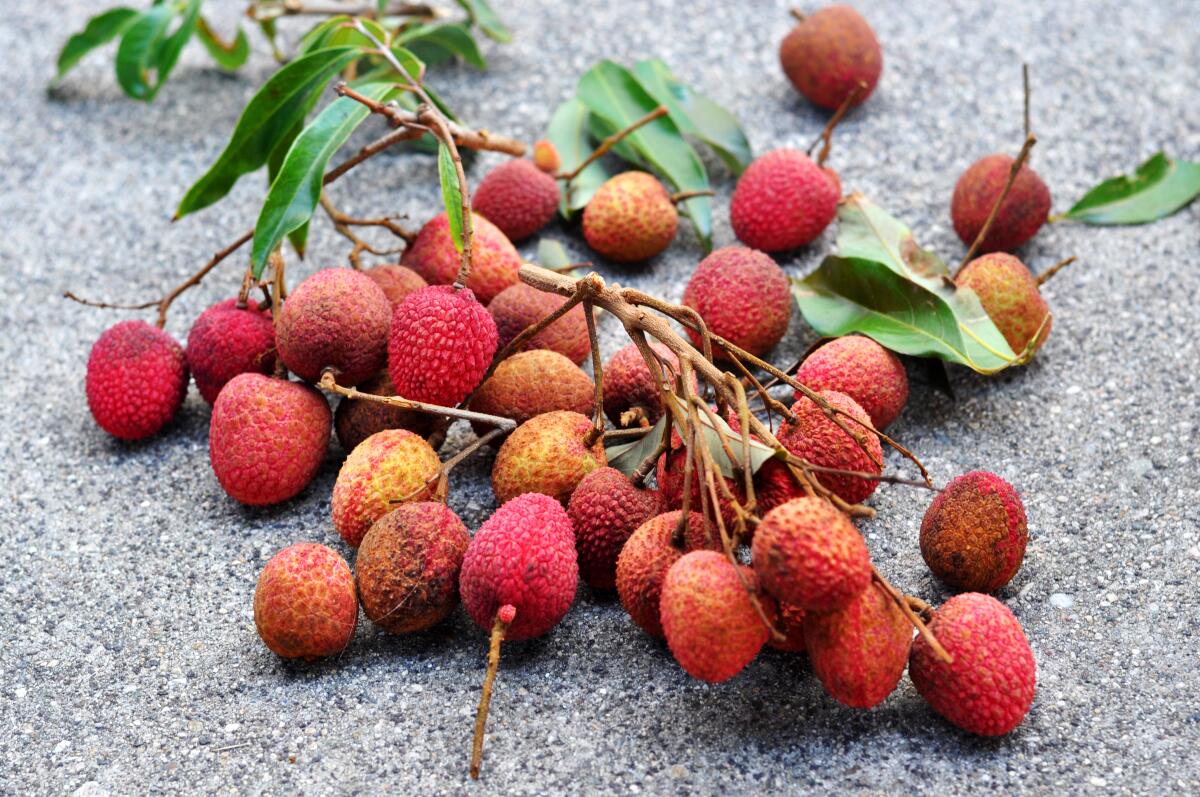L.A. Farmers Market Guide: Lychees are here for only a few weeks, and they’re mind-blowing

- Share via
A few months ago, I sat in a lychee orchard in Zengcheng, China, under a canopy of fruit-laden branches, peeling and eating as much of the fruit as was humanly possible, convinced that I’d have to pilgrimage back to southern China before I tasted the good stuff again. Lychees are oddly sensual and deeply addictive: pearl-colored, succulent fruits that taste kind of like grapes perfumed with rosewater. Then last Sunday I spotted a table with bags of just-picked lychees, their mottled pink obscured by branches, on a table at the Alhambra farmers market.
Behind the table, cutting up branches loaded with lychees, was Robert Dimitman, whose late father, Jerry, a professor of plant pathology at Cal Poly Pomona, planted lychee trees in his Covina orchard. “Such was the mystique that he cultivated, along with some of the state’s oldest, largest and rarest exotic Asian fruit trees, that he and his family always insisted that his home’s location remain unspecified to deter intrusions by overzealous fruit lovers,” wrote David Karp of Jerry Dimitman in his 2012 obituary.
Or as Robert put it to me: “People’ll be dodging lead to come my way.”
Robert took over the management of his father’s Kwa Luk Gardens, named after a celebrated variety of lychee, and has continued to bring the lychees from about 30 trees as well as other fruit to the Alhambra market. Sunday was the first picking of what will be a very short season. “Lychees, especially with all the heat, just go boom.” The fruit splits, explained Robert’s sister, Susan Dimitman Purdy; their brother Steven also was at the stand. “Unfortunately I don’t know how to talk to them or pet them the way he did,” Robert said of his father’s fruit-handling skills.
“I don’t know the names of them,” Robert said about the gorgeous fruit — they have five kinds of lychees on the Covina ranch — although he thought Sunday’s batch might be the Brewster, or Chen Purple, a type named after the Chen family in Guangdong, China, known for their lychee farming. “Dad tagged them with a marker that’s smudged off. He never intended it for a cash crop; he was just growing them for his Cantonese friends.”

What: Get as many lychees as you can eat in a day or so. Although you can make stuff with the fruit, they’re best eaten as close to picking as possible, and eaten plain. (Susan reminds me that Alhambra soda fountain Fosselman’s makes lychee ice cream; she makes her own, but then again she grew up in a lychee orchard.)
Where: Robert Dimitman brings his fruit only to the Alhambra farmers market, on Sundays from 8 a.m. to 1 p.m. His father also favored that market, a small, well-curated and neighborly market that caters to the local Asian American community.
When: The Dimitmans’ lychees are available for a very small window of time, perhaps as long as a month. This year, Robert says he’ll bring the fruit for the next two Sundays: Sept. 1 and 8. Is a third week possible? Stranger things have happened. It’s farming.
Tip: Arrive early, to state the obvious, and bring cash. Though Robert says both he and his father customarily sold the 1-pound-plus bags of lychees for $5, this year they’re going for $10. If you miss them, don’t (utterly) despair: The Dimitmans hope to bring wampees in a few weeks, then longans and pomelos, though those plans are contingent upon weather.
More to Read
Eat your way across L.A.
Get our weekly Tasting Notes newsletter for reviews, news and more.
You may occasionally receive promotional content from the Los Angeles Times.











